



STOPPER KNOTS
You can use a stopper to prevent a rope or yarn from unfolding, but please do that only in cheap rope/yarn. Use a proper whipping in all other cases.
This is the simplest knot. Therefore probably the most
used. The knot is very useful to support knots in yarns. The loose ends become
a bit thicker. When this support makes the total bend too bulky you have to
look for another bend. The overhand knot is not strong, so it is not used in
situations where you might expect great force. It also reduces the strength of
the rope or yarn by about 50%. But as an "anti-slip-knot" it does not
have to withstand a lot.
The Double Overhand knotThe double overhand knot is beautiful, thicker than the common
overhand knot, but not any stronger. But use it with caution. The double
overhand knot is also called the bloodknot when it is used at the end of a
whip. This knot has several ways of tying and in principle two ways of working
up. Both ways of tying shown here also show both results. The bloodknot shown
in the middle is the preferred way of working up the second way of tying marked
with the crosses. The bloodknot is very hard to untie after it has been under
stress. If you put an object through the cross-marked hole the knot will work
up as the strangleknot. It is usefull to practice
this way.
 If
you make more than two turns in the overhand knot it wil be fatter.
(But hardly
stronger.) In
twined rope it is important to work up the knot very
carefully. (It will not
only look neater, it wil prevent 'kinking' which will weaken the rope
even
more!)
If
you make more than two turns in the overhand knot it wil be fatter.
(But hardly
stronger.) In
twined rope it is important to work up the knot very
carefully. (It will not
only look neater, it wil prevent 'kinking' which will weaken the rope
even
more!)
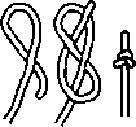 This
knot is larger, stronger and more easy to untie than the overhand knot.
It does
not harm your rope as much as the overhand knot does. So therefore
sailors use
this knot in most cases. (! not for bend support, where the smaller
overhand is
used, or in rope, a permanent small stopper)
This
knot is larger, stronger and more easy to untie than the overhand knot.
It does
not harm your rope as much as the overhand knot does. So therefore
sailors use
this knot in most cases. (! not for bend support, where the smaller
overhand is
used, or in rope, a permanent small stopper)
 The
reef-knot is only useful in simple applications. Ashley says "it is a
true
Binder Knot, for which it is admirable, but under no circumstances
should it be
used as a bend." It is easy tied and will not jam, so it is always easy
to
untie. It is used to tie packages, and as a base for he shoe-bow.
Sailors used
it for binding rolled sails or better reefed sails. And that is where
it got
its english name from. Americans call it the square knot. Probably
because it
looks square, or because it was much used on square-rigged-ships, but
that is a
total guess of me.
The
reef-knot is only useful in simple applications. Ashley says "it is a
true
Binder Knot, for which it is admirable, but under no circumstances
should it be
used as a bend." It is easy tied and will not jam, so it is always easy
to
untie. It is used to tie packages, and as a base for he shoe-bow.
Sailors used
it for binding rolled sails or better reefed sails. And that is where
it got
its english name from. Americans call it the square knot. Probably
because it
looks square, or because it was much used on square-rigged-ships, but
that is a
total guess of me.
Its relatives, the granny, the thief-knot and the what-knot all have
their
purposes, but not as a trustful knot.
 This
knot is dangerous, and untrustful. One moment is slips the other it
jams. It is
best to ban it out from your habits.
This
knot is dangerous, and untrustful. One moment is slips the other it
jams. It is
best to ban it out from your habits.
 The
story goes sailors used this knot on their bags for they did not trust
landsman. If a thief closed the bag after his theft, he would close it
with a
reef-knot, which is detectable by the sailor.
The
story goes sailors used this knot on their bags for they did not trust
landsman. If a thief closed the bag after his theft, he would close it
with a
reef-knot, which is detectable by the sailor.
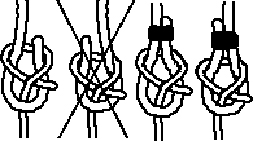 The sheet
bend is my
favorite bend. Be careful. With the loose end on the wrong side you
have an
other, weaker knot (Left-hand sheetbend). If the knot is well seized it
does
not matter if it is tied right or left handed
The sheet
bend is my
favorite bend. Be careful. With the loose end on the wrong side you
have an
other, weaker knot (Left-hand sheetbend). If the knot is well seized it
does
not matter if it is tied right or left handed
For more
information on the reef-knot-family you may visit the Sheetbend Family.
The The Carrick Bend / The Josephine Knot
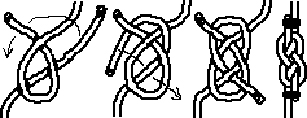 Also
known as Full
carrick Bend, Sailor's Knot and Anchor Bend. Beware! There are not many
knots
with so much wrong drawings as this bend. The ends have to be on
opposite sites
and the crossings always are alternating up/down/up/down... The Carrick
Bend is
one of the best knots. Ashley states it is possible the nearest thing
we have
to a perfect bend. It does not easily slip, not even if the rope is
wet. And it
is always easy to untie, also after a heavy load. If used as a Hawser
bend in
heavy material it is always seized and parceled to save wear. The
Josephine
Knot In the Macrame this knot is called the Josephine Knot. It is self
evident the Josephine knot is not seized nor pulled tight.
Also
known as Full
carrick Bend, Sailor's Knot and Anchor Bend. Beware! There are not many
knots
with so much wrong drawings as this bend. The ends have to be on
opposite sites
and the crossings always are alternating up/down/up/down... The Carrick
Bend is
one of the best knots. Ashley states it is possible the nearest thing
we have
to a perfect bend. It does not easily slip, not even if the rope is
wet. And it
is always easy to untie, also after a heavy load. If used as a Hawser
bend in
heavy material it is always seized and parceled to save wear. The
Josephine
Knot In the Macrame this knot is called the Josephine Knot. It is self
evident the Josephine knot is not seized nor pulled tight.
The
Fisherman's Knot
may be laid in two different ways. Which of both the is the stronger, I
do not
know. With 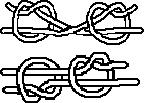 two
equal overhand knots
it is symmetrical. This is probably the most used variant.
two
equal overhand knots
it is symmetrical. This is probably the most used variant.
With two different overhand knots you get the most beautiful version (always work it up neatly!) Only ... The double eight is stronger, easier to untie after use and as decorative from all sides as the true lovers at best.
Although it looks
difficult to tie, it is actually very easy. Fast 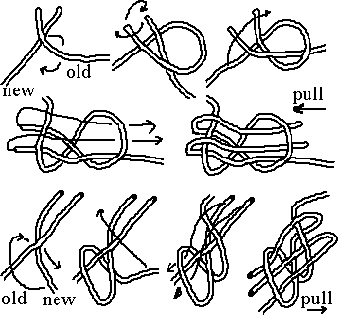 to
tie with small material,
and reliable for wool, linen and most other weaver materials. Because
both
loose ends fall back over the standing part, it has an almost perfect
lead. Hold both threads together on the crossing between your thumb and
finger.
(first drawing)
to
tie with small material,
and reliable for wool, linen and most other weaver materials. Because
both
loose ends fall back over the standing part, it has an almost perfect
lead. Hold both threads together on the crossing between your thumb and
finger.
(first drawing)
Twist both threads together while you hold the cross in two simple
movements.
(first/Second drawing)
Now, you pull over the
standing part of the line you tie on, (third drawing)
And put both loose ends over the line you tie on through the loop you
just
created. Now let loose the cross and hold the loose ends fixed to the
standing
part of the line you tie with and pull the knot tight. This knot is
related
with The (Flemish)
Eight. You can observe this by removing the thread you tied the knot
with, leaving the thread you tied the knot on unchanged. If you have
difficulties in learning this knot, you can start by practicing the
Flemish
eight in the thread you want to tie on, using an imaginary thread to
tie with.
For the
other
direction
:
A weaver on a traditional weaving loom never knows in advance in what
direction
the next line has to be tied. Therefore he has to know two ways of
tying the
weaver knot. One for each direction. This is the same Weavers-Eight but
tied
different. Tied this way the knot points to the other direction.
HITCHES
(also
called The Simple Hitch) Although this is probably the simplest knot of
all, you have
to be a skilled knot-tyer 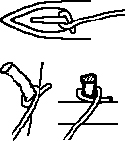 to know
how to tye and use it in a safe way. The
loose end of the rope is nipped against the object and the standing
part. The
best nip is obtained against an edge or shoulder. If the load is
released and the
standing part shaken, the hitch is spilled instantly. It is used to
attatch
rope to a belay-pin, a weaver needle or even to a tree branch, to start
belaying, to start winding or as a temporary easy to spill made-fast.
to know
how to tye and use it in a safe way. The
loose end of the rope is nipped against the object and the standing
part. The
best nip is obtained against an edge or shoulder. If the load is
released and the
standing part shaken, the hitch is spilled instantly. It is used to
attatch
rope to a belay-pin, a weaver needle or even to a tree branch, to start
belaying, to start winding or as a temporary easy to spill made-fast.
This
is the capsized overhand knot. It is very useful to carry light loads
which
have to be removed
easily. Ashley  recommends
it to use it for hanging store to out of reach for
mice. It should not be disturbed.
recommends
it to use it for hanging store to out of reach for
mice. It should not be disturbed.
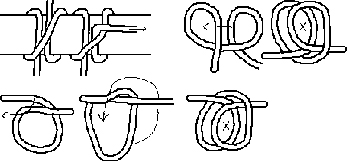 This is
a very important knot of only theoretical value.
Without extra support, it is untrustworthy in any situation, except as
a
crossing knot. You have to learn it for scouting and at sailing
schools. If you
have to use it, work it up properly; pull length-wise only at both ends
before
you load the working end. It is better to use The Rolling Hitch
instead.
This is
a very important knot of only theoretical value.
Without extra support, it is untrustworthy in any situation, except as
a
crossing knot. You have to learn it for scouting and at sailing
schools. If you
have to use it, work it up properly; pull length-wise only at both ends
before
you load the working end. It is better to use The Rolling Hitch
instead.
The
two half hitches is used for tieing a rope with a right-angle pull to a
pole or
ring. It should be
constant under  load.
(Not under constant load). It does not jam. If the object
you tye it on has a small diameter it is better to use the "Round Turn
with Two Half Hitches". This is the same knot but with an extra turn
round
the object.
load.
(Not under constant load). It does not jam. If the object
you tye it on has a small diameter it is better to use the "Round Turn
with Two Half Hitches". This is the same knot but with an extra turn
round
the object.
The
Buntline Hitch is (was) used to tie a buntline to a square sail. It is
a secure
knot, but it tends to jam, so it is  not easy
to untie. Therefore, it is useful
for work that will be left unattended for longer periods, since it will
not
untie suddenly.
not easy
to untie. Therefore, it is useful
for work that will be left unattended for longer periods, since it will
not
untie suddenly.
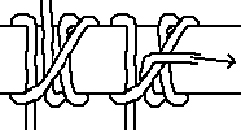 The
best simple hitch for lengthwise pull. It needs to be laid very
carefully and
pulled firmly before loading. Never use it for right angle pull, for it
will
spill.
The
best simple hitch for lengthwise pull. It needs to be laid very
carefully and
pulled firmly before loading. Never use it for right angle pull, for it
will
spill.
This
is a remarkably useful knot. It is adjustable AND trustworthy. Each
sailor
should know how to tye this knot in  any
circumstance. Especially to tye himself
to a rescue rope thrown to him in the water. On the lifeline he has to
hold the
loose end securely to the standing part. This gives a good grip and a
useful
goal in this critical situation (HOLD!) Anyone who uses a tent should
know this
knot. It is the best way to adjust your lines to the tent-poles. It is
the most
simple of the adjustable knot family.
any
circumstance. Especially to tye himself
to a rescue rope thrown to him in the water. On the lifeline he has to
hold the
loose end securely to the standing part. This gives a good grip and a
useful
goal in this critical situation (HOLD!) Anyone who uses a tent should
know this
knot. It is the best way to adjust your lines to the tent-poles. It is
the most
simple of the adjustable knot family.
This
brother of the midshipman’s Hitch is just a bit less important. This is
because
it tends to jam. When jamming is
desirable, this knot is o.k., as when work
will be left unattended. Ashley states it was used by cotton brokers in
New Bedford to tie their
cotton samples they took from mill to mill. The packages could be
opened and
closed at will, and still be secure when left alone at travel.
is
desirable, this knot is o.k., as when work
will be left unattended. Ashley states it was used by cotton brokers in
New Bedford to tie their
cotton samples they took from mill to mill. The packages could be
opened and
closed at will, and still be secure when left alone at travel.
This
hitch is really useful for tieing a cow to a pole so it can graze round
it. You can add an overhand knot  at the
loose end as a stopper. Sailors use it to secure a lanyard to
a shroud.
at the
loose end as a stopper. Sailors use it to secure a lanyard to
a shroud.

It is used to tie timber.
This
hitch is very practical to lash long objects. The working end needs
only one
tug and will not slip easy. Before 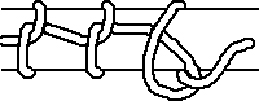 the
'tiewrap' (or how are they called) this
hitch was used by electrical engineers to tie 'wiring-trees' A row
marls hitches
is best started en ended with a double marls hitch.
the
'tiewrap' (or how are they called) this
hitch was used by electrical engineers to tie 'wiring-trees' A row
marls hitches
is best started en ended with a double marls hitch.
The
strangle knot is important as temporary whipping and as permanent
binding from
which you need more  in line.
Laid well it is virtually impossible to untie
without tools (needle or knife). So never use it if you need to untie.
Used as
marl hitch it is best used as first and last in a row. Or when a row
becomes
'dangerously' long this hitch is used as insurance between shorter
rows. Be
careful!. Tied in this way the working end (or the bundle) needs only
one tug,
but it is not enough to pull once, it needs to be worked up properly!
in line.
Laid well it is virtually impossible to untie
without tools (needle or knife). So never use it if you need to untie.
Used as
marl hitch it is best used as first and last in a row. Or when a row
becomes
'dangerously' long this hitch is used as insurance between shorter
rows. Be
careful!. Tied in this way the working end (or the bundle) needs only
one tug,
but it is not enough to pull once, it needs to be worked up properly!
The
constrictor knot is important as temporary whipping and as permanent
binding
from which you need 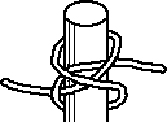 more than
one in a row, but not in line (when you should
use the strangle knot). Laid well, it is virtually impossible to untie
without
tools (needle or knife). Never use it if you need to untie it. It is
almost the
strongest among the 'simple' hitches. Only the double constrictor is
stronger.
Because the constrictor may be tied in a bight, it is often preferred
over the
strangle knot.
more than
one in a row, but not in line (when you should
use the strangle knot). Laid well, it is virtually impossible to untie
without
tools (needle or knife). Never use it if you need to untie it. It is
almost the
strongest among the 'simple' hitches. Only the double constrictor is
stronger.
Because the constrictor may be tied in a bight, it is often preferred
over the
strangle knot.
The
Bowline Knot is one of the most used loop knots. This variant is most
used in
the world. Probably due to its 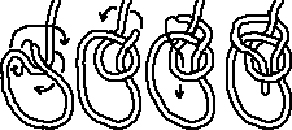 simplicity,
security, and its relationship with
the Sheet bend. Keep the cross point in step A between a finger and
thumb and
make a clock-wise turn with your wrist. Without the loop in between, it
is the
same knot. If the loop is expected to be heavily loaded, the bowline
is, in fact,
not secure enough. There is a rule of thumb which states that the loose
end
should be as long as 12 times the circumference for the sake of safety.
simplicity,
security, and its relationship with
the Sheet bend. Keep the cross point in step A between a finger and
thumb and
make a clock-wise turn with your wrist. Without the loop in between, it
is the
same knot. If the loop is expected to be heavily loaded, the bowline
is, in fact,
not secure enough. There is a rule of thumb which states that the loose
end
should be as long as 12 times the circumference for the sake of safety.
The
Dutch Navy uses this variant of the bowline. And, of course, the Dutch
sailor
says this one is superior. The 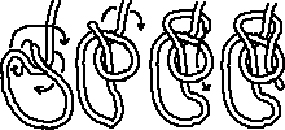 working
end is not so easy pushed back by
accident, they say. I think it is just a difference in culture. There
is a rule
of thumb which states that the loose end should be as long as 12 times
the
circumference for the sake of safety.
working
end is not so easy pushed back by
accident, they say. I think it is just a difference in culture. There
is a rule
of thumb which states that the loose end should be as long as 12 times
the
circumference for the sake of safety.
The
double eight is a knot used by climbers. It is easy to tie and safer as
the
bowline. There is a discussion whether there should be a stopper at the
end of
the loose end or not. Speed of (un)tying is a safety factor itself.  The
first
way of tying is equal to the way of tying the flamish eight, but now in
a double rope.
The 'loose-end' is the loop. This way is only applicable when the loop
is
'empty' during tying. If the loop
is to be tied round something (round "your waist" for instance) you
first tie an eight then lay the loop and double the eight. It is
important to
have enough rope for the loop. It requires experience, so start
practicing.
The
first
way of tying is equal to the way of tying the flamish eight, but now in
a double rope.
The 'loose-end' is the loop. This way is only applicable when the loop
is
'empty' during tying. If the loop
is to be tied round something (round "your waist" for instance) you
first tie an eight then lay the loop and double the eight. It is
important to
have enough rope for the loop. It requires experience, so start
practicing.
The
Bowstring Knot is an ancient knot that is used as an eye for
bowstrings. The
knot is simple and strong. Once tied
and pulled firmly, you do not want to
untie it: you might call it a good 'tie-once' loop knot. The bowstring
knot is
appreciated because it is small, strong, secure, and easy to tie. It's
neat
because it does not have loose ends. Modern archers prefer fixed
spliced loops.
If the loose (cross marked) end is not secured within the loop between
the bow
and loop, it is wise to add a small overhand knot as stopper.
tied
and pulled firmly, you do not want to
untie it: you might call it a good 'tie-once' loop knot. The bowstring
knot is
appreciated because it is small, strong, secure, and easy to tie. It's
neat
because it does not have loose ends. Modern archers prefer fixed
spliced loops.
If the loose (cross marked) end is not secured within the loop between
the bow
and loop, it is wise to add a small overhand knot as stopper.
If
you need a good looking and strong loop this is a good candidate. The
Loose end
must be at least two to  three
rope diameters long. But if you make the loose
end inflexible with for instance glue, resch or by melting and you can
hide it
almost completely inside the two round turns. The "tucked double
overhand"
is a permanent loop. It jams badly, but that’s what it is made for.
three
rope diameters long. But if you make the loose
end inflexible with for instance glue, resch or by melting and you can
hide it
almost completely inside the two round turns. The "tucked double
overhand"
is a permanent loop. It jams badly, but that’s what it is made for.
An excellent easy to tie loop for applications needing a loop in another place than the rope-end, but somewhere in the middle. It has an excellent lead, and is secure even if the forces on both ends are stronger than the load in the loop.
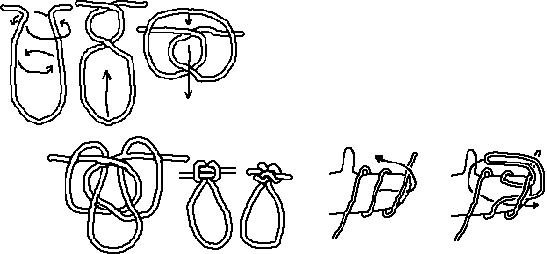
A
practical and easy to tie loop for applications needing a loop in
another place
than the rope-end but somewhere in the middle. It is not  as
strong as the butterfly but is a bit faster to tie and untie. As the
name already suggests it was used by the artillery (for carrying their
guns
over the shoulder.) Do not pull the rope too hard when the loop is not
loaded.
It is best used as temporary knot for carrying things. As always, work
up the
knot neatly!
as
strong as the butterfly but is a bit faster to tie and untie. As the
name already suggests it was used by the artillery (for carrying their
guns
over the shoulder.) Do not pull the rope too hard when the loop is not
loaded.
It is best used as temporary knot for carrying things. As always, work
up the
knot neatly!
A
hitch to tie a pebble or a breastplate to a necklace. You have to make
sure the
object is secured in the loop. If  you use
a loop (this loop) to tie a pebble or
other nice stone to a neck loop without extra (visible) support it is
wise to
use a leather neck loop. Make a cut in the length of the inside of the
loop.
Not too deep; it is only to roughen the surface to improve the grip of
the
knot. And last but not least..... use a good shoemakers glue. The
result is
surprising. The pendant hitch is closely related to the True Lovers or
Fisherman's Knot.
you use
a loop (this loop) to tie a pebble or
other nice stone to a neck loop without extra (visible) support it is
wise to
use a leather neck loop. Make a cut in the length of the inside of the
loop.
Not too deep; it is only to roughen the surface to improve the grip of
the
knot. And last but not least..... use a good shoemakers glue. The
result is
surprising. The pendant hitch is closely related to the True Lovers or
Fisherman's Knot.
The
third noose is based on the Multi fold-Overhand-knot. As its second
name already suggests it has a dark 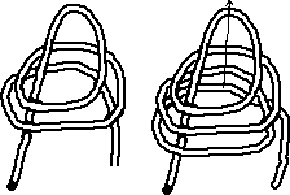 history.
It is also used as a knot to tie
angling-rods to fish line.
history.
It is also used as a knot to tie
angling-rods to fish line.
This
knot is used for the gallows-tree as well. The force to close it is
adjusted
better than with the gallows knot.  And
because it is bigger in the neck it is
believed to break the neck more easy. That would make it more
mercy-full as the
gallows-knot which kills by strangling. The Hangman is also used as a
knot to
tie angles to fish line.
And
because it is bigger in the neck it is
believed to break the neck more easy. That would make it more
mercy-full as the
gallows-knot which kills by strangling. The Hangman is also used as a
knot to
tie angles to fish line.
This
is the only 'wrong' running noose. Applications
for. It to tie a package and for tying YoYo's. Experts use one  loop to
make it
possible to let the yoyo spin on the end and to call it up with a
little firm
pull. The yoyo has to spin fast and the noose has to be trimmed
carefully.
Starters use two loops and tie it firmly.Use eventually an
overhand-knot on the
cross-marked ends.(This is not the best way to fasten your YoYo. If you
want to
use the best technique you have to un-twine a line with two
yarns and
re-twine one of the yarns by doubling it with the YoYo in the middle.
Free-spinning the YoYo my wear out the loop.)
loop to
make it
possible to let the yoyo spin on the end and to call it up with a
little firm
pull. The yoyo has to spin fast and the noose has to be trimmed
carefully.
Starters use two loops and tie it firmly.Use eventually an
overhand-knot on the
cross-marked ends.(This is not the best way to fasten your YoYo. If you
want to
use the best technique you have to un-twine a line with two
yarns and
re-twine one of the yarns by doubling it with the YoYo in the middle.
Free-spinning the YoYo my wear out the loop.)
The
Monkey Fist is used as an end knot for a heaving line. A heaving line
is a line
used for throwing from one 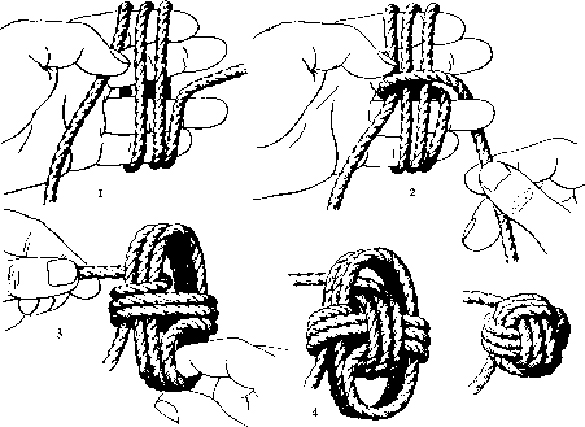 location
to another. This enables a larger line that
could not be thrown over the distance to be pulled over. The most
common use of
a heaving line is at sea, to pull a cable to shore from a ship. A cable
is not
easily thrown over a distance of 10m [ ft]or more, so instead one
throws a
heaving line. The line is tied to the cable and when it has been
received the
cable can then be pulled over. To make it easier to throw one needs to
connect
a weight on the end of the line - usually a stone, lead-ball or a small
bag of
sand is connected to the end. Better still a small rope ball is tied on
the
end. It is neat, it will endure many tosses last long and it is easily
thrown.
That is what the monkey fist is was originally used for. Now it is also
used as
fancy knot for key-rings, necklaces and so on. The knot can be done
with or
without a central core (i.e. a round stone or ball bearing) to add
extra weight
but it is recommended to use extra loops depending on the size of the
object.
location
to another. This enables a larger line that
could not be thrown over the distance to be pulled over. The most
common use of
a heaving line is at sea, to pull a cable to shore from a ship. A cable
is not
easily thrown over a distance of 10m [ ft]or more, so instead one
throws a
heaving line. The line is tied to the cable and when it has been
received the
cable can then be pulled over. To make it easier to throw one needs to
connect
a weight on the end of the line - usually a stone, lead-ball or a small
bag of
sand is connected to the end. Better still a small rope ball is tied on
the
end. It is neat, it will endure many tosses last long and it is easily
thrown.
That is what the monkey fist is was originally used for. Now it is also
used as
fancy knot for key-rings, necklaces and so on. The knot can be done
with or
without a central core (i.e. a round stone or ball bearing) to add
extra weight
but it is recommended to use extra loops depending on the size of the
object.
You
need to hook in
the cross marked place. The force F you apply at the loose end is
multiplied by
(almost) 3 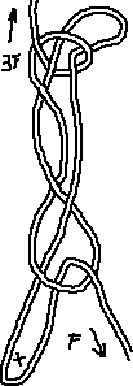 on
the standing part. You may say it is only a rope tackle. Beware,
it wears out your precious rope fast, so if you use it often it is wise
to use
a form of protection in the bight where the loose end is pulled
through. A
folded paper will do, a smooth piece of leather is much better.
on
the standing part. You may say it is only a rope tackle. Beware,
it wears out your precious rope fast, so if you use it often it is wise
to use
a form of protection in the bight where the loose end is pulled
through. A
folded paper will do, a smooth piece of leather is much better.